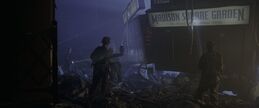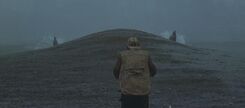This film is one of my childhood memories, but I have always watched it with special effects and large-scale destruction shots. Recently, I saw many people take it with the Japanese version and the remake of Godzilla by Legendary Pictures. I just take it seriously. After examining this movie, what is the relationship between this movie and the title "Godzilla"? This will start from a long time ago.
In the spring of 1954, the United States conducted a nuclear explosion test on the Bikini Islands in the South Pacific, which affected the Japanese fishing boat "Fukulong Maru". All the crew on the ship were killed. This incident caused a sensation in Japanese society. It was Japan’s "third nuclear strike." After hearing about this, Toho Film Company’s producer Tanaka Yuyuki and director Honda Inoshiro decided to shoot a nuclear-themed movie. They recruited Tsuburaya Eiji (later the father of Ultraman) to design special effects for this film. The plot fits the social environment at the time, telling the story of the big monster Godzilla landing in Japan after being awakened by a nuclear explosion.
"Godzilla" in 1954, the plot is serious, the tone of the movie is slow and heavy and depressed. Godzilla embodies a sense of heaviness and power in the slow motion. Godzilla's head is designed in the shape of a mushroom cloud, basically a walking atomic bomb. , Tokyo after being destroyed by Godzilla is basically the same as the ruins of the Hiroshima nuclear explosion. In the end, Godzilla, a symbol of nuclear weapons, was wiped out by secretly researched anti-biological weapons, and the doctor who created this weapon also chose to commit suicide to ensure that this new type of weapon does not fall into the hands of outsiders.
Nuclear weapons will eventually be replaced by stronger weapons as society progresses. What remains unchanged is the oppression of mankind under the destructive power created by itself, just like the mushroom cloud in Hiroshima, and Godzilla awakened by a nuclear explosion. Godzilla symbolizes the destructive power created by mankind himself, and it cannot be stopped by mankind himself.
This film is the first monster movie with a post-modern style. It was released in Japan that year, and the number of viewers surpassed tens of millions, making Toho Pictures a lot of money. Two years later, Godzilla was introduced to the United States. New York set a 47-week release record. This film is also Japan's first monster movie using special camera technology, creating a precedent for special camera monster movies.
In the following 20 years, Godzilla launched many sequels, and its image has been changing, sometimes as a god of destruction, sometimes as a hero who protects children. It also spawned many movies (such as monster films with a unified world view, such as Moslararton), and finally created the earliest monster movie universe.
Godzilla has gradually become a phenomenon-level cultural symbol.
In the 1980s, Godzilla was still advancing with the times. In the 1984 movie "Godzilla: The Resurrection of the Monster King", Godzilla wreaked havoc and threatened the competition between the United States and the Soviet Union. Eliminate Godzilla with nuclear weapons
After launching a series of films in the 1990s, Toho Pictures decided to come to an end and sold the copyright to Samsung Pictures, under the direction of commercial film director Roland Emmerich. At first, Godzilla’s image design was strict in Japan. However, the designer described Godzilla as a reptile lizard on the grounds of missing the design draft.
The 1998 American version of "Godzilla" has a concise plot and does not focus on the character and social background. It focuses on the two aspects of "monster" and "destruction", but at this time Godzilla has become a one The ugly big lizard, under the heroism of American movies, is so weak and vulnerable to being killed by missiles (the Japanese version of Godzilla is an unstoppable existence, sea, land, and air fires and even nuclear explosions cannot be killed) because of production The cost is high, it has a large number of cg destruction shots, but it loses the strength and oppression that Godzilla has maintained for a long time, and becomes climbing stairs and punching holes. . A large number of shots depict Godzilla, who should have been unstoppable, being chased and beaten by American aircraft and tanks. . .
The film has been criticized by fans all the time. It has drastically changed the image of Godzilla, the classic IP, turning it into a mutant monster in traditional movies, and even laying eggs (severe complaints), and the film is filled with a large number of 90s Black humor and a few over-fascinated characters (not counted in the b-level movies), the quality and production of this film are sufficiently sophisticated, but it is destined to become a popcorn movie, not a classic, and not even a qualified one. "Godzilla" movie.
The real Godzilla is a phenomenon-level cultural symbol. It has launched nearly 40 movies in 60 years. This great monster king will continue to follow the times and stay famous in the history of movies, continuing to roar towards the industrial age. Go down.
View more about Godzilla reviews











